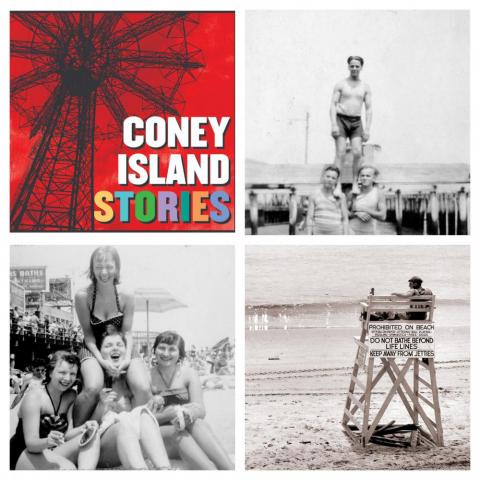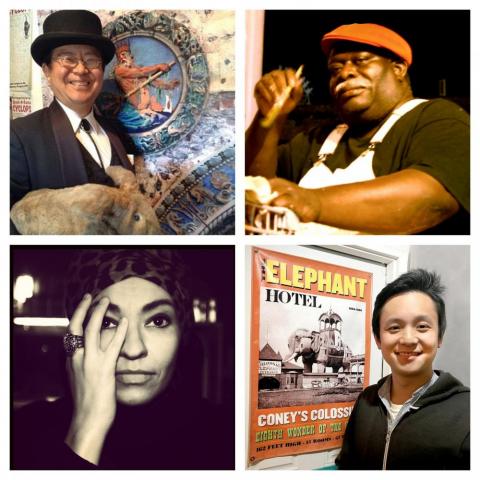
Season 1 Episode 10: Sign Painters and Artists
Episode 10 shares the stories of Coney Island sign painters as well as artists and designers who’ve been inspired by Coney’s celebrated signage, all taken from the History Project’s Oral History Archive. The Coney Island style of hand-painted signs was perfected more than a century ago by Wildman and Sons, a shop in the heart of the amusement manufacturing district just off Surf Avenue. Amusement signs were meant to stand out and be instantly readable from a distance on the chaotic streets of Coney Island.

Season 1 Episode 9: Love and Marriage
Episode 9 features the stories of couples who met, got engaged or married in Coney Island, all taken from the History Project’s oral history archive. Visitors to our exhibition center often tell us that they or their parents or grandparents met or had their first date in Coney Island. Over the years, we’ve witnessed marriage proposals on the Wonder Wheel and weddings and wedding party rides on the Cyclone roller coaster.

Season 1 Episode 8: Beach Days
On Memorial Day Weekend, lifeguards will once again be perched in their towers and New York City will celebrate the reopening of Coney Island's beach for swimming. Episode 8 shares the stories of days at the beach from the 1920s through the 1990s taken from the Coney Island History Project's Oral History Archive.

Season 1 Episode 7: Staying in the Game
Episode 7 features the stories of independent game operators, past and present, from the Coney Island History Project Oral History Archive. Among the games that Peter Agrapides, Monica Ghee, Candi Rafael, and Eliot Wofse have operated over the years are Fascination, Balloon Dart, Glass and Dime Pitches, Milk Toss, Basketball, Fish Bowl, High Striker and Water Races. The last of the independents who have stayed in the game are now concentrated on a small strip of Coney Island’s eclectic Bowery, once the boisterous home of hundreds of unusual games and attractions.

Season 1 Episode 6: A Century of Bathhouses
Episode 6 features the stories of bathhouse owners, workers and patrons from the Coney Island History Project’s oral history archive. Bathhouses were the first businesses in Coney Island. Even before Coney’s first hotel was built in 1829, crude bathhouse shacks were set among the dunes. Before the city built the boardwalk in the 1920s, most of the Coney Island beach was private and bathhouses provided the only access to the beach and were a summer home away from home for patrons.

Season 1 Episode 5: Legendary Roller Coasters
Episode 5 features the stories of a trio of roller coasters built in the Roaring 20’s and named after violent storms: the Thunderbolt, the Tornado and the Cyclone. While the Cyclone is the only survivor from Coney's golden age, the Coney Island History Project has recorded and preserved memories of people who rode, owned, or worked at some of these legendary coasters. A few narrators had the unusual fortune to live beneath one of these thrill rides.

Season 1 Episode 4: Immigrant Stories of Mermaid Avenue
This episode of Coney Island Stories features the stories of Mermaid Avenue’s mom and pop businesses founded by immigrants, past and present. Please scroll down for earlier episodes.

Season 1 Episode 3: Immigrant Stories of Artists at Work
This episode of Coney Island Stories features the stories of visual artists from Jamaica, Japan, Russia, and China who found a place they could call home in Coney Island and neighboring Gravesend and Brighton Beach. Please scroll down for earlier episodes.

Season 1 Episode 2: Immigrant Stories of Coney Island Restaurants, Part II
This episode of Coney Island Stories features the stories of Coney Island food businesses owned or operated by immigrants from Greece, Mexico, Jamaica and Russia.

Season 1 Episode 1: Immigrant Stories of Coney Island Restaurants
This episode of Coney Island Stories features the stories of Coney Island restaurants and food stands founded by immigrants in the first part of the 20th century as told by their mom-and-pop owners and family members.
